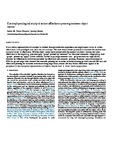Electrophysiological study of action-affordance priming between object names.
| dc.contributor.author | Feven-Parsons, IM | |
| dc.contributor.author | Goslin, Jeremy | |
| dc.date.accessioned | 2018-07-04T12:59:51Z | |
| dc.date.issued | 2018-09 | |
| dc.identifier.issn | 0093-934X | |
| dc.identifier.issn | 1090-2155 | |
| dc.identifier.uri | http://hdl.handle.net/10026.1/11799 | |
| dc.description.abstract |
If our central representation of an object is defined through embodied experience, we might expect access to action affordances to be privileged over more abstract concepts. We used event-related potentials to examine the relative time course of access to affordances. Written object names were primed with the name of an object sharing the same affordance as the target (e.g. precision-grip: "grape" primed by "tweezers") or the same taxonomic category (e.g. fruit: "grape" primed by "apple"). N200 latencies, related to go/nogo semantic category decisions on target words, revealed no difference in facilitation provided by affordance and semantic priming. However, separate analyses of ERPs for go and nogo trials showed that semantic priming led to earlier activation during go trials (around 430 ms), and affordance priming led to earlier activation during nogo trials (around 180 ms). While affordances appear to be peripheral to the conceptual representation of objects, they do lead to direct motor preparation. | |
| dc.format.extent | 20-31 | |
| dc.format.medium | Print-Electronic | |
| dc.language | en | |
| dc.language.iso | en | |
| dc.publisher | Elsevier | |
| dc.subject | Affordances | |
| dc.subject | EEG | |
| dc.subject | Event-related potentials | |
| dc.subject | Go/nogo | |
| dc.subject | Language | |
| dc.subject | Masked priming | |
| dc.subject | Semantic decision task | |
| dc.subject | Sensorimotor | |
| dc.subject | Visual word recognition | |
| dc.title | Electrophysiological study of action-affordance priming between object names. | |
| dc.type | journal-article | |
| dc.type | Journal Article | |
| plymouth.author-url | https://www.ncbi.nlm.nih.gov/pubmed/29935302 | |
| plymouth.volume | 184 | |
| plymouth.publication-status | Published | |
| plymouth.journal | Brain and Language | |
| dc.identifier.doi | 10.1016/j.bandl.2018.06.002 | |
| plymouth.organisational-group | /Plymouth | |
| plymouth.organisational-group | /Plymouth/Faculty of Health | |
| plymouth.organisational-group | /Plymouth/Faculty of Health/School of Psychology | |
| plymouth.organisational-group | /Plymouth/REF 2021 Researchers by UoA | |
| plymouth.organisational-group | /Plymouth/REF 2021 Researchers by UoA/UoA04 Psychology, Psychiatry and Neuroscience | |
| plymouth.organisational-group | /Plymouth/REF 2021 Researchers by UoA/UoA04 Psychology, Psychiatry and Neuroscience/UoA04 REF peer reviewers | |
| plymouth.organisational-group | /Plymouth/Research Groups | |
| plymouth.organisational-group | /Plymouth/Research Groups/Centre for Brain, Cognition and Behaviour (CBCB) | |
| plymouth.organisational-group | /Plymouth/Research Groups/Centre for Brain, Cognition and Behaviour (CBCB)/Brain | |
| plymouth.organisational-group | /Plymouth/Users by role | |
| plymouth.organisational-group | /Plymouth/Users by role/Academics | |
| dc.publisher.place | Netherlands | |
| dcterms.dateAccepted | 2018-06-10 | |
| dc.rights.embargodate | 2019-6-20 | |
| dc.identifier.eissn | 1090-2155 | |
| dc.rights.embargoperiod | Not known | |
| rioxxterms.versionofrecord | 10.1016/j.bandl.2018.06.002 | |
| rioxxterms.licenseref.uri | http://www.rioxx.net/licenses/all-rights-reserved | |
| rioxxterms.licenseref.startdate | 2018-09 | |
| rioxxterms.type | Journal Article/Review |


